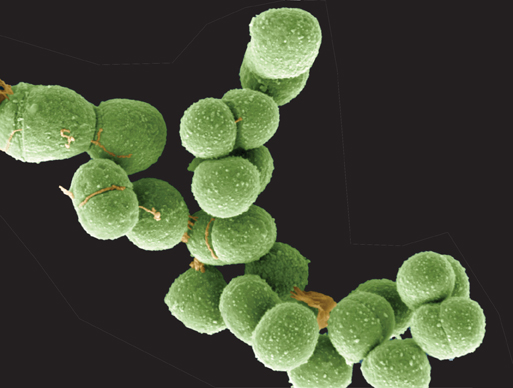Archaea

KEY CHARACTERISTICS
Archaea are prokaryotes that differ from bacteria in so many details of structure and metabolism that they are viewed as a different domain than bacteria. Genetically, they have more in common with eukaryotes than with bacteria. Their cell walls do not contain peptidoglycan.
Cell Structure Cells similar to those of bacteria in appearance; many have flagella that are different in structure and biochemical composition from bacterial flagella. Cell membrane lipids also different from those of bacteria; few internal organelles
Genetic Organization As in bacteria, all essential genes are in one large DNA double helix that has its ends joined to form a closed loop. Proteins responsible for transcription and translation are similar to those of eukaryotes. Also like eukaryotes, most species contain introns, and all species contain DNA-binding histone proteins.
Reproduction By binary fission; no true sexual reproduction, but some achieve recombination by conjugation.

These halophilic archaea thrive in salty environments. (SEM 25,000X)
• Did You Know?

The volcano Solfatara, near Naples, Italy, is home to many archaea in the genus Sulfolobus.
Hot Enough for You?
The Original Extremists
Way before extreme sports and extreme reality TV shows came the archaea—the original and ultimate extremists. When archaea were first discovered, biologists called them extremophiles, a term that literally means “lovers of the extreme.” For many archaea, the name still fits. In fact, they have proven especially difficult to grow in the lab, since they require such extreme temperatures and dangerous chemical conditions to thrive. One species will grow only in sulfuric acid! Archaea found in deep-sea ocean vents thrive in temperatures exceeding 100° Celsius, while others enjoy life in the frigid waters of the Arctic.
Table of Contents
- Formulas and Equations
- Applying Formulas and Equations
- Mean, Median, and Mode
- Estimation
- Using Measurements in Calculations
- Effects of Measurement Errors
- Accuracy
- Precision
- Comparing Accuracy and Precision
- Significant Figures
- Calculating With Significant Figures
- Scientific Notation
- Calculating With Scientific Notation
- Dimensional Analysis
- Applying Dimensional Analysis




